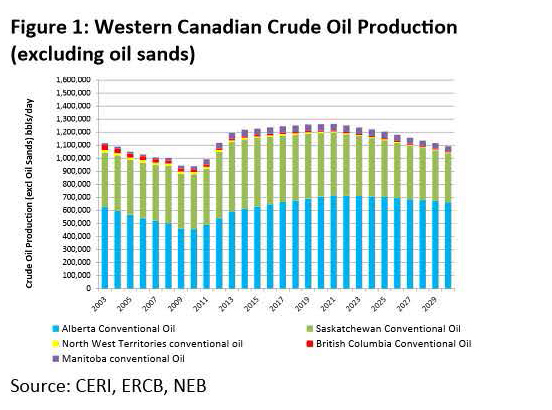November 2013, Vol. 240 No. 11
Features
CERI Finds Resurgence In Western Canada Oil Production

Conventional oil production in Western Canada has experienced a resurgence in the past few years due largely to new drilling and completion methods, according to a report from the independent Canadian Energy Research Group (CERI).
The growth seen in the region’s production during 2010 and 2011 was the first recorded in a decade and reversed the downward trend in light and medium crude production since its peak in the 1970s.
According to data in Conventional Oil Supply Costs in Western Canada, drilling in Canada is dominated by oil-targeted rigs with horizontal wells combined and hydraulic fracturing increasing rapidly over the past few years.
Technological advances, cost reductions and sustained high oil prices over the past few years have enabled a shift toward these deeper and more capital-intensive wells, the report said.
The analysis shows on average new wells drilled in 2012 across the Western Canadian Sedimentary Basin (WCSB) were economic and at current oil price levels would recover their full costs and earn a positive rate of return. Weighted average supply costs for the WCSB were $40/bbl for horizontal wells and $64/bbl for vertical wells.
The most economical areas for drilling were split across Alberta, BC and Saskatchewan. In Alberta, the Cold Lake area, the Lloydminster formation in central-eastern Alberta, the Cardium formation northwest of Calgary and the Slave Point formation in north-central Alberta had the lowest supply costs, each well below the average for the WCSB, ranging from $15-31/bbl.
Despite significantly higher capital costs, the Shekilie area in northeastern British Columbia proved attractive with the supply cost for vertical wells estimated at $17/bbl.
In Saskatchewan, the southwest, central-west and central northwest areas, encompassing the Viking and Lower Shaunavon formations are shown to be competitive, with supply costs ranging from $23-34/bbl. Even with lower production volumes compared with some Alberta areas, significantly lower capital and operating costs in Saskatchewan result in “competitive well economics” for these areas.
Gas Output Continues Downward Trend
In a separate report, Conventional Natural Gas Supply Costs in Western Canada, conventional natural gas production in Western Canada continued on a downward trend that began in 2005. Drilling activity slowed markedly during the period due to depressed gas prices are making the economics of producing natural gas challenging, CERI said.
Production out of the Marcellus and other shale developments in the United States has dramatically increased North American natural gas supply and is the main reason why natural gas prices have remained so low.
The fleet of drilling rigs in Canada is dominated by oil-targeted rigs, with natural gas drilling rigs comprising only 27% of the drilling rig fleet. Most natural gas drilling rigs are now horizontal, with technological advances and cost reductions over the past few years enabling a shift toward these deeper and more capital-intensive wells, the report showed.
The data showed average wells drilled in 2012 across the Western Canadian Sedimentary Basin (WCSB) would not recover their full costs or earn a positive rate of return at current natural gas prices. Weighted average supply costs for the WCSB were estimated to be $4.79 Mcf for vertical wells and $5.71 Mcf for horizontal wells.
The analysis covers the revenues and costs associated with producing natural gas; any revenues and costs associated with the production of NGLs have not been included in these estimates. Many producers have switched investment toward liquid-rich gas resources to take advantage of the additional revenues that can be generated through NGLs, CERI said.
The majority of study areas considered in this analysis would need a higher natural gas price to be considered economical. The most promising of the areas were located in northeast British Columbia, reflecting the quality of the gas resources in the Montney formation. The central and southwestern parts of Alberta and central northwest Saskatchewan were also considered economical at current gas price levels.
The purpose of the reports, CERI said, was to provide an indicator of the economic viability of oil and gas production across the region, analyzing drilling rig activity to calculate the supply cost of new wells drilled in 2012.
Note: All estimates in this report are in 2012 Canadian dollars which closed the year at 0.995 vs. 1.00 U.S. dollar.





Comments